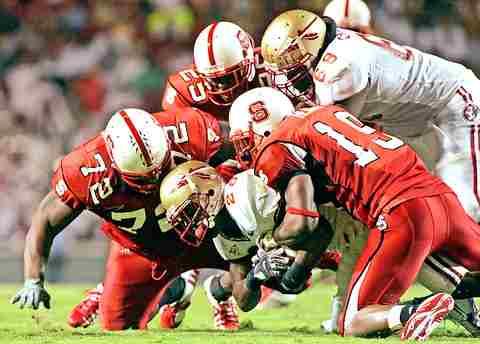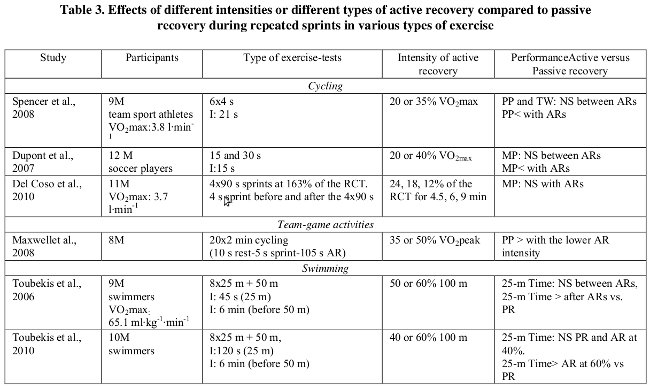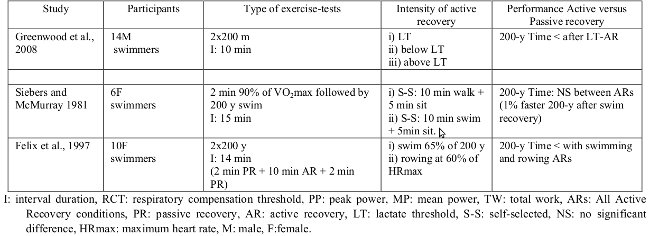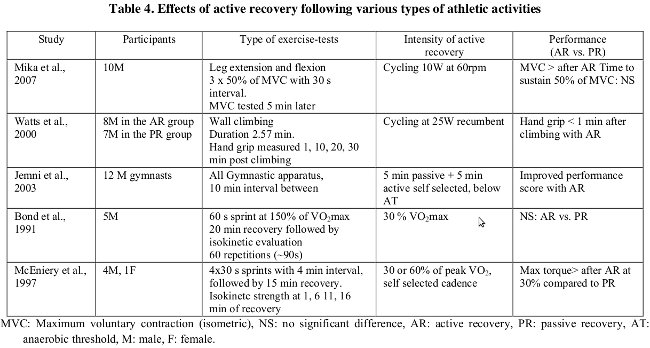Athletes are advised to follow a cool-down practice after a high intensity training session or after competition. The main reason for this practice is to enhance the lactate removal and recovery of homeostasis. It is believed that this will facilitate the recovery of performance before the next session. However, active recovery following a training session may not offer any advantage for performance (Barnett, 2006).
Table 3. Effects of different intensities or different types of active recovery compared to passive recovery during repeated sprints in various types of exercise
I: interval duration, RCT: respiratory compensation threshold, PP: peak power, MP: mean power, TW: total work, ARs: All Active Recovery conditions, PR: passive recovery, AR: active recovery, LT: lactate threshold, S-S: self-selected, NS: no significant difference, HRmax: maximum heart rate, M: male, F:female.
Table 4. Effects of active recovery following various types of athletic activities
MVC: Maximum voluntary contraction (isometric), NS: no significant difference, AR: active recovery, PR: passive recovery, AT:
anaerobic threshold, M: male, F: female.
More recent studies have investigated the effectiveness of active recovery immediately after a training session on performance before the next session. Tessitore et al. (2007) and Tessitore et al. (2008) examined the effects of different modes of 20 min active and passive recovery following a soccer training session and following futsal soccer games on performance 5 hours later. It was found that performance on several anaerobic tests such as the squat-jump, the countermovement jump, bounce-jump and 10 m sprint time were not affected by the mode of recovery, which included dry-land or water-based active recovery, electrostimulation, or passive rest (Tessitore et al., 2007, 2008). It is likely that the training stimulus was moderate and the recovery process of these athletes following training or competition was well-designed (players followed proper hydration and nutrition) and these may have masked any effect of the recovery interventions.
A study applied with international level female soccer players extended the performance testing 69 hours following a friendly game between national teams (Andersson et al., 2008). Active recovery was applied 22 and 46 hours following the match and included 60 minutes of low intensity cycling and low intensity resistance training (60% of HRmax; <50%1RM). Performance during a 20-m sprint, countermovement jump and isokinetic strength were not different following either active or passive recovery (Andersson et al., 2008).
Similar results were obtained by King and Duffield (2009) in female netball players after a session including various sport specific activities. Fifteen minutes of active recovery at an intensity of 40% of the velocity at VO2max (vVO2max) or passive recovery showed similar effects on performance during five vertical jumps height and five 20-m sprints time both tested before a second session 24-hours later (King and Duffield 2009). The total stress imposed to the athletes during these non-controlled game-sport conditions is high enough to cause fatigue. Probably the active recovery applied after training session or a match is not appropriate to enhance performance recovery of selected tests in well-trained players. However, the effect of active recovery on the next training session on the overall game performance has not so far examined.




